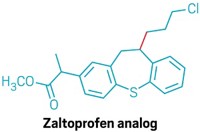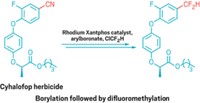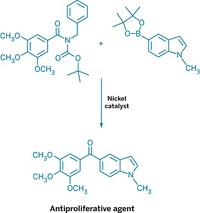Advertisement
Grab your lab coat. Let's get started
Welcome!
Welcome!
Create an account below to get 6 C&EN articles per month, receive newsletters and more - all free.
It seems this is your first time logging in online. Please enter the following information to continue.
As an ACS member you automatically get access to this site. All we need is few more details to create your reading experience.
Not you? Sign in with a different account.
Not you? Sign in with a different account.
ERROR 1
ERROR 1
ERROR 2
ERROR 2
ERROR 2
ERROR 2
ERROR 2
Password and Confirm password must match.
If you have an ACS member number, please enter it here so we can link this account to your membership. (optional)
ERROR 2
ACS values your privacy. By submitting your information, you are gaining access to C&EN and subscribing to our weekly newsletter. We use the information you provide to make your reading experience better, and we will never sell your data to third party members.
Materials
Catalysis With Graphene Oxide
Organic Chemistry: Ultrathin sheets mediate multiple transformations
by Carmen Drahl
July 19, 2010
| A version of this story appeared in
Volume 88, Issue 29

In another first for the versatile graphene family of materials, graphene oxide has been found to catalyze alcohol and alkene oxidations as well as alkyne hydrations (Angew. Chem. Int. Ed., DOI: 10.1002/anie.201002160). The discovery suggests that graphenes could be useful beyond the realm of displays and electronics.
Graphene oxide is an intermediate along traditional routes to graphene, the atom-thick carbon sheets that have taken materials science by storm. But chemists know relatively little about graphene oxide’s inherent reactivity. “We wondered if graphene oxide was a powerful enough oxidant to oxidize substrates that would be of interest to the synthetic community,” says organic chemist Christopher W. Bielawski of the University of Texas, Austin.
The answer was yes, as Bielawski learned with graduate student Daniel R. Dreyer and postdoc Hong-Peng Jia. With ambient oxygen as the terminal oxidant, they used graphene oxide to make ketones and aldehydes from selected alcohols, alkynes, and olefins. It’s tough to stop oxidation of a primary alcohol at the aldehyde stage instead of proceeding all the way to the carboxylic acid, so graphene oxide could be a valuable addition to the synthetic tool kit, Bielawski notes.
“Since graphene oxide sheets behave like a surfactant, their catalytic applications could extend to oil-water biphasic systems,” says Northwestern University graphene oxide specialist Jiaxing Huang.
This work points to a growing trend of using carbon-rich materials as an alternative to transition metals in catalysis, says Dang Sheng Su of the Max Planck Society’s Fritz Haber Institute, in Germany. Su is part of a team that showed surface-modified carbon nanotubes can dehydrogenate n-butane. The method has potential as a green alternative to metal-mediated catalysis, but graphene oxide production is not yet a green process, Su says.
The Texas team is now unraveling the mechanism of the transformation, in particular thinking about how graphene oxide’s surface area may be involved. “I don’t think this reactivity is unique to graphene oxide. There are other chemically modified graphenes out there,” Bielawski says. “This is the tip of the iceberg.”





Join the conversation
Contact the reporter
Submit a Letter to the Editor for publication
Engage with us on Twitter